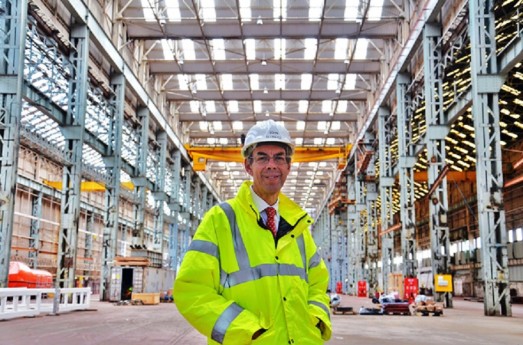
Merseyside shipyard and engineering services company Cammell Laird has won a £1.5million tender with Innovate UK to develop electron beam welding technology in the ship building, offshore and nuclear sectors.
Cammell Laird will act as primary contractor to test the equipment at its Birkenhead site using its team of welders and engineers, together with partners TWI Limited which will provide research, and support in welding codes and standards. The third partner, Cambridge Vacuum Engineering will manufacture the electron beam machine.
John Eldridge principal engineer at Cammell Laird said the two-year project will assess whether electron beam welding can be made to work in a large-scale production environment such as shipbuilding and the construction of nuclear power plants.
“We are delighted to win this competitive tender with our partners,” he said. “Work is already under-way and although the technology has been around for decades it has been only used on relatively small size applications. Electron beam welding is a very clean form of metal joining where the two parts are fused together by a heat generated by a beam of high-velocity electrons. If we can show it can work in a production environment on large welded structures, our project will mark a massive change in the fabrication industry across the maritime, renewables and nuclear industries.”
Mr Eldridge said lab tests at TWI have shown huge potential benefits of large scale electron beam welding.
“At present if you are welding the thick-walled tube vessels for a nuclear power plant, or monopiles on a wind turbine you would typically use arc welding which is time-consuming and expensive. The electron beam, however, makes a weld in a single pass which improves quality and slashes the time and energy consumption required in traditional welding. For example, if you are welding thinner sections of a ship’s hull the electron beam’s lower energy input reduces distortion and the need for corrective action after welding. On certain jobs we see that electron beam welding could save tens of hours of labour time. It also provides an opportunity for our highly skilled welders to upskill to more advanced technology led welding roles. It is great to see Cammell Laird spearheading world-leading innovation, a role we have played for generations in the maritime industry by, for example, making the first all steel ship, the first all welded ship and the first screw steamer to cross the Atlantic.”
Chris Punshon TWI industry group manager said:
“It is particularly encouraging to see the installation of local vacuum EB welding technology, on-site at a significant steel fabricator of the calibre of Cammell Laird. This is a culmination of more than a decade of development initially under the umbrella of TWI’s Core Research Programme and latterly at Cambridge Vacuum Engineering with TWI’s support. This represents a great opportunity to demonstrate the effectiveness of this powerful manufacturing process in nuclear fabrication for use in the UK power industry and expanding export market.”
Cambridge Vacuum Engineering managing director Bob Nicolson said the large scale electron welding machine will now begin construction following the winning of the tender and will be delivered to Cammell Laird in around 12 months.
“Our revolutionary EBFlow technology, fully developed and pioneered in Britain, will transform the productivity of fabrication processes throughout the world of heavy engineering. In many cases the speed of welding can be 30 times faster than current methods. By reducing the cost of ‘thick section’ steel structures commonly used in nuclear as well as a range of other industrial sectors, EBFLow will help play a vital role in the development of the global low carbon economy.”
Photo credit Polaris media
